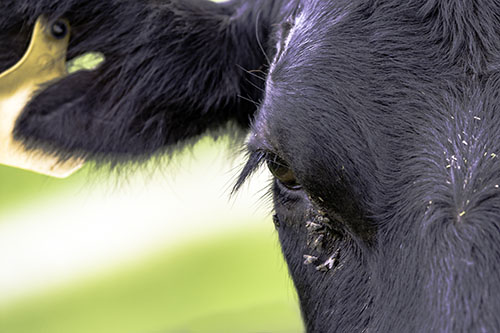Controlling and Treating Pink Eye
Jun 01, 2021

For cattle producers, one of the most significant concerns is preventing pinkeye. Though pinkeye can be a tough disease to control, a thorough understanding of this disease will make dealing with this troublesome infection less frustrating.
Pinkeye is a bacterial infection that infects the eyes of cattle and is transmitted by the face fly. Most of these infections are caused by Moraxella bovis. Lately, however, more cases of a separate bacteria known as Moraxella bovoculi have been cultured from cases of pinkeye. This fact is highly relevant because traditional pinkeye vaccines do not provide protection against this new strain of the bacteria. Additionally, this new strain can be difficult to treat and the traditional treatment of oxytetracycline may not be effective.
Symptoms of pinkeye can vary and may be mild to severe. Many cases start out as excessive tearing or “watering” of the eye. Cattle may be sensitive to light and may have a visible “spot” in the eye. Some cases may progress to corneal edema which appears as a blue colored eye or possibly even to a full-blown abscess of the eye.
Most cases of pinkeye respond well to injectable oxytetracycline. The long-acting product works well since many cases will not have to be treated more than once with that product. Some resistant strains or the bovoculi strain may require a stronger or script antibiotic for treatment.
Controlling pinkeye must be a multifaceted approach. Since pinkeye is transmitted by the face fly, the cornerstone of any control program must be fly control. Face fly ear tags are essential to good fly control. Experts recommend one tag in each ear of adult cattle and one tag for calves. Measures to control eye irritation are also important; therefore, keeping pastures clipped is extremely important. Vaccination is another key component to good pinkeye prevention. Though vaccines are not effective against the bovoculi strain, current available vaccines do a good job in helping prevent Moraxella bovis. Some recent research even suggests that vaccination in the face of a pinkeye outbreak has some benefit in controlling/preventing new cases of pinkeye. Finally, make sure the animal is in a good nutritional plan to ensure the immune system is able to function at its best. This will allow vaccines to work properly and also ensure the animal’s natural defenses are fully effective.
While pinkeye can certainly be a challenging summer problem, a full understanding of this infection can help mitigate some of the difficulties associated with the infection. Check with your local Co-op to find animal health products that can help control and/or prevent pinkeye.
For more content like this, check out the latest issue of the Cooperator.
Pinkeye is a bacterial infection that infects the eyes of cattle and is transmitted by the face fly. Most of these infections are caused by Moraxella bovis. Lately, however, more cases of a separate bacteria known as Moraxella bovoculi have been cultured from cases of pinkeye. This fact is highly relevant because traditional pinkeye vaccines do not provide protection against this new strain of the bacteria. Additionally, this new strain can be difficult to treat and the traditional treatment of oxytetracycline may not be effective.
Symptoms of pinkeye can vary and may be mild to severe. Many cases start out as excessive tearing or “watering” of the eye. Cattle may be sensitive to light and may have a visible “spot” in the eye. Some cases may progress to corneal edema which appears as a blue colored eye or possibly even to a full-blown abscess of the eye.
Most cases of pinkeye respond well to injectable oxytetracycline. The long-acting product works well since many cases will not have to be treated more than once with that product. Some resistant strains or the bovoculi strain may require a stronger or script antibiotic for treatment.
Controlling pinkeye must be a multifaceted approach. Since pinkeye is transmitted by the face fly, the cornerstone of any control program must be fly control. Face fly ear tags are essential to good fly control. Experts recommend one tag in each ear of adult cattle and one tag for calves. Measures to control eye irritation are also important; therefore, keeping pastures clipped is extremely important. Vaccination is another key component to good pinkeye prevention. Though vaccines are not effective against the bovoculi strain, current available vaccines do a good job in helping prevent Moraxella bovis. Some recent research even suggests that vaccination in the face of a pinkeye outbreak has some benefit in controlling/preventing new cases of pinkeye. Finally, make sure the animal is in a good nutritional plan to ensure the immune system is able to function at its best. This will allow vaccines to work properly and also ensure the animal’s natural defenses are fully effective.
While pinkeye can certainly be a challenging summer problem, a full understanding of this infection can help mitigate some of the difficulties associated with the infection. Check with your local Co-op to find animal health products that can help control and/or prevent pinkeye.
For more content like this, check out the latest issue of the Cooperator.